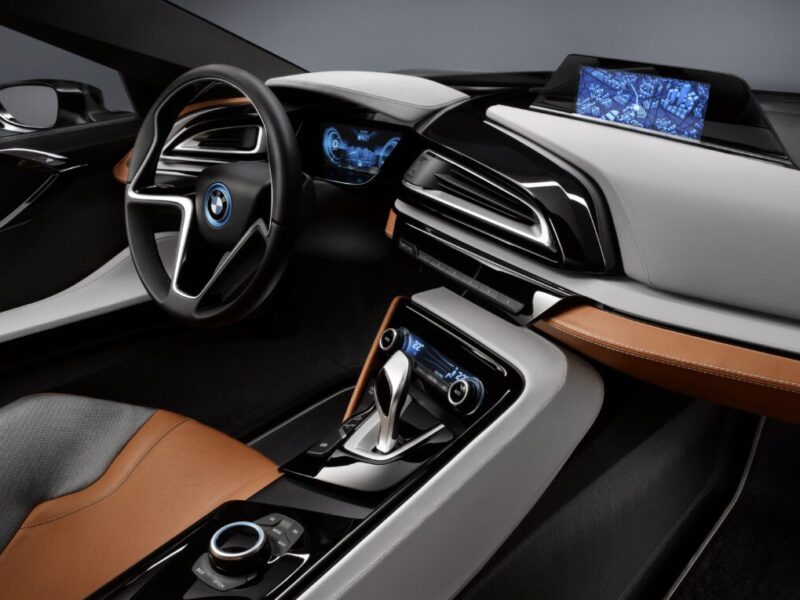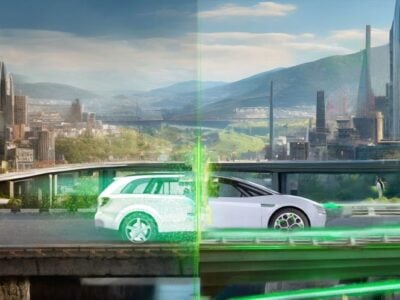
The i8 ConceptSpyder has all the ingredients of a real sports vehicle – a twin-turbo gasoline engine with 164 kilowatts (223 hp), combined with an electric motor of 96 kW accelerate the vehicle to a speed of 100 kmph in 5 seconds on the way to an electronically governed top speed of 250 km/h (155 mph). Nevertheless, when it comes to fuel consumption, the vehicle behaves more humbly than most subcompacts: According to BMW, the perfect balancing of electric and conventional drive along with elaborated energy recovery functions and extremely light body made of carbon-fibre-reinforced plastic (CFRP) reduce fuel consumption to about 3 liters per 100 km which equals a fuel economy of 94 mpg imp in the European test cycle.
Another feature of the BMW i8 Concept Spyder is the ability to send power through the front, rear or all four wheels at the same time. Intelligent control electronics ensure that the optimum drive configuration is available for the situation at hand. The driver can view the driving mode currently engaged and monitor the activity of the two drive sources on information displays in the cockpit. Furthermore, the electronic systems ensure maximum energy recuperation under braking or when coasting.
The lithium-ion hybrid battery supplying the motor with power can be recharged in an extremely short space of time from any domestic power socket, BMW promises. The battery is housed in a place called by the BMW engineers "energy tunnel" which connects front and rear axle and, by the way, helps to achieve a perfect weight balance of 50:50 between front and rear axle.
A defining element in the car body is the headlights with laser light technology which follow BMW’s U-shaped design template. The cockpit brings together the instrument panel, steering column and steering wheel with the instrument cluster, a large central information display and control elements. Two further displays inside the vehicle make up the interface between the car, its passengers and the outside world. Positioned alongside the instrument cluster behind the steering wheel, the central information display flags up all relevant information and assists the driver in the use of connectivity applications.
In terms of connectivity, BMW i drivers have a new generation of driver assistance systems at their disposal which significantly enhance both safety and comfort. For example, the camera-based proactive Collision Warning system, Parking Assistant and Traffic Jam Assistant ensure all on board can enjoy a safe and relaxed journey.
In addition, BMW i is developing an array of innovative connectivity functions which provide a seamless link between its models and their owners’ lives outside the car. Remote functions accessed via a smartphone help users to locate their car in large car parks (CarFinder), show nearby charging stations, allow the battery to be charged at pre-set times and inform drivers on the current status of their vehicle. Plus, the battery and interior can be brought up to peak operating temperature before the driver sets off on a journey. The ‘Last Mile’ Navigation function assists drivers after they have parked their car, with route instructions transferred directly onto their smartphone directing them along the last leg of their journey on foot – to a museum or restaurant, for example. An intermodal route planning function integrates the car into the local public transport network and provides information on current parking availability at the driver’s destination.
The car’s power electronics are linked up to intelligent navigation and traffic guidance systems to enable the hybrid drive system to work at maximum efficiency. In this way, information on route profile, speed limits and traffic congestion are incorporated into the calculations of the energy management system so that the hybrid system’s operating strategy can be adapted accordingly. For example, proactive charging of the hybrid battery allows the Concept Spyder to negotiate a traffic tailback on the road ahead using electric power alone – and therefore without producing any emissions.
Another smart connectivity application is the automatic diary synchronization with the driver’s smartphone. The system registers upcoming appointments and, when plugged into a power socket, ensures that the battery is topped up overnight so that the car is ready for action with a fully charged battery the following morning.
The vehicle however is less regarded as a preview to a real roadster version but more as a glimpse to the development status of BMWs technology. Insiders say that the carmaker plans to roll out a similarly equipped coupe but not a two-seater in about two years.
 If you enjoyed this article, you will like the following ones: don't miss them by subscribing to :
eeNews on Google News
If you enjoyed this article, you will like the following ones: don't miss them by subscribing to :
eeNews on Google News


